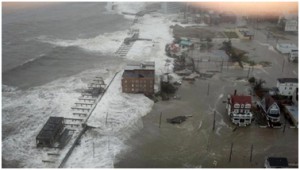New Jersey Future Blog
New Jersey Enters National Disaster Resilience Contest
February 27th, 2015 by Megan Callus
Successful applicants will receive up to $1 billion in funding for project design and implementation
The New Jersey Department of Environmental Protection posted its draft application for the National Disaster Resilience Competition (pdf) on Friday, Feb. 20, making it potentially eligible to receive up to $1 billion in federal funds.
The U.S Department of Housing and Urban Development announced the competition on Sept. 17, 2014, allowing communities recently struck by natural disasters to compete for $1 billion in funding. Modeled on the Rebuild By Design effort, the goal of the competition is to help communities recover from natural disasters and improve their ability to prepare for and withstand future disasters. The competition is structured in two phases: (1) risk assessment and planning; and (2) design and implementation.
NJDEP’s phase one application focuses on creating replicable pilot projects that address flooding risks in estuarine communities (communities at risk for coastal flooding, but not oceanfront wave action, such as many of New Jersey’s “back bay” communities). The proposed “layered flood risk reduction measures” range from home elevation and wetlands preservation and restoration to buyouts of homes in flood-prone areas. If selected to participate in phase two of the competition, the state will identify specific pilot projects and articulate their design and means of implementation.
The department hosted two public hearings this week to collect feedback on the application and will accept written comments through March 6, 2015. New Jersey Future testified at the hearing in Little Ferry on Tuesday, attended the meeting in Atlantic City on Wednesday and will be submitting formal written comments. NJDEP will submit the final application on March 27, 2015.
NJDEP’s application to the NDRC could bring a tremendous opportunity to obtain additional federal funds to make New Jersey more resilient to future storms and flooding events. At the meeting, New Jersey Future commended the application’s acknowledgement of sea-level rise and associated flooding risks as well as the multi-pronged strategy approach to reducing these risks. New Jersey Future also noted that the application should be strengthened by including a clearer explanation of how the needs of vulnerable populations will be addressed and by defining in more detail the process for engaging the public, particularly low- to moderate-income residents. It commented that the application could also be improved by committing in the design phase to the identification of specific flood elevation standards.
Interested parties are encouraged to review the draft and offer suggestions to aid the state in submitting an award-winning application.

















